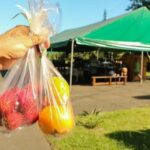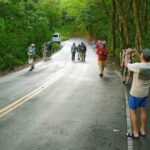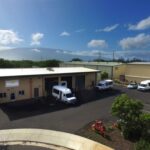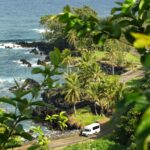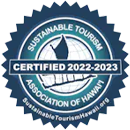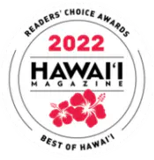Eco-friendly Vacations In Maui
Take An Eco-Friendly Vacation To Maui
Hawaii is at the forefront of renewable energy and ecotourism. Maui is proving to be the perfect testing ground for many brand new energy technologies. From solar, wind and wave power to electric vehicles and green certified accommodations and tours, there is no better place to experience the eco-vacation of a lifetime than Maui!
Maui is ideally suited for eco-tourism. After all, people travel to the island because of the ecology – the beaches, mountains, rainforest, and ocean. It’s only natural that the maintenance of this environment would be of concern to visitors and locals alike. Just as the ancient Hawaiians practiced sustainability in their daily lives, today’s travelers are aware that sustainable eco-travel is worthwhile for the planet and can even help revive the environmentally-challenged places to which they travel.
According to The International Ecotourism Society, ecotourism involves “responsible travel to natural areas that conserves the environment and improves the well-being of local people.” Maui has been setting the pace for Hawaii in many ways by expressing this concept on the local level as well as in the tourism industry.
While most of Maui’s attractions and vendors are as eco-friendly as possible, there are those dedicated to not only caring for the environment with eco-sustainable business practices but to educating visitors about the culture and history of “Malama the aina.”
Tips For Going Eco-Friendly
Travel is becoming more than something purely based on a destination. People want to emotionally connect and learn about the environment and culture of the beautiful destination they are visiting.
Part of that emotional connection is the feeling that you’ve done right by the land and locals. In Hawaii, we call this “Keeping it Pono,” Pono meaning “do what’s right to help keep life in balance.” According to the book “Managing with Aloha”, Pono is rightness and balance. When you are Pono, you have a feeling of contentment, wherein all is good, and all is right. Pono teaches the attitude of positivity. Those who are Pono are optimistic, full of hope and life itself excites them. All they see in their future is that things can only get better. When you are Pono, the Aloha you feel is the Aloha you’ll share.
Try Going Car-Free
Take The Maui Bus or a tour that pick you up at your hotel / condo.
Learn Something
Take time to discover something new and get connected to others and the land.
Eco-Friendly Activities
Go with the reef-safe companies and activities in Hawaii that are helping the environment and supporting social causes.
The Future Of Tourism
How and Why Travel Can Transform You
In the future, tourism will be more complex, more demanding and more sophisticated. Travelers will want more and for a lower price. Business innovation will be important and essential to sustaining a high quality of service and experience while preserving resources for future growth.
We want to see new cultures, sample, and experience what they have to offer. Jack Soifer, the author of the book “The Future of Tourism,” says that what we want from our vacations are changing. We can see this in things like food tourism, farm stays and volunteer travel. He lists these four things describing what most of today’s travelers want.
Today’s travelers are much more sophisticated than in any other time in history. With smartphones and the internet there is no longer such a thing as a “lost tourist”…at least that’s what most people like to think. However, until you get out into the community and venture beyond the resort and tourist areas will you experience the lifestyle of a place. It goes double for Hawaii as the lifestyle and culture are often unlike what you may have experienced elsewhere. It’s one of the reasons that “Aloha” is universally known throughout the world.
What We Want In An Eco-Friendly Vacation
Individualized Attention
We have high expectations. No one wants to be one of 1000 at a destination. They want small, emotionally connecting experience. Travel is not just about old buildings or cultures but what those buildings and cultures are communicating to each visitor.
Niche Experience
Small segments of personalized experiences – customized or boutique tours and resorts.
Integration
into a culture, nature and local products. Many different things integrated into a vacation –
Fair Business – Fair Trade
Sustainable durable goods, community development (will pay more for). Elite travel not fair to young travelers (everyone deserves piece of the cake). We don’t want misery for low prices or cost to us. We want dignity and a nice life for all. This makes us feel better about travel.
Traveling To Learn
Maui has an incredible amount of natural wonders. Respecting the fragility of a limited land mass was something the ancient Hawaiians recognized from the beginning. That is why the native Hawaiian concept of “Malama the aina,” meaning “caring for the land,” is an important part of the cultural story.
A recent survey asked people near the end of life what their biggest regret is. Over 90% mentioned that they wished they had traveled more. The routine of daily life is hard to break. However, humans are a traveling species. Most religions origin stories are based on someone going into the wilderness to have a transforming revelation about life. These transformative types of stories are, in a way, what we hope to experience when we go on vacation. At the very least we hope to get away from the norm. Family and romance come up time and again as reasons we travel to exotic destinations. But there is a difference between being a tourist and being a traveler. Nowadays people want more than a crowded location packed with souvenir stores. Many of today’s travelers are looking for the ultimate souvenir, a broader perspective.
Travel becomes a story. What you learn about the destination is passed on, like a baton, to your friends and family. Will you engage and learn from a different culture or will you look for the McDonalds?
According to the UN World Travel Organization, the current number of people who traveled in 2015 was just over 1 billion. They estimate that number may double in 10 years and could increase to 4.3 billion by 2050. Imagine double the people visiting your favorite vacation destination! It will put a tremendous strain not only on the environment but the infrastructure and labor to service all this growth. The growth is fueled by wealth, access and resources which are increasing globally every year. We must be more open to caring for the places we visit so the next generation can enjoy the places we enjoy today.
Eco Friendly Transportation
According to the Hawaii Tourism Authority, 2.5 million visitors traveled to Maui in 2015. At Maui’s airport, 11,000 movements (all flights including helicopters, cargo, etc.) happen per month in Kahului. It’s difficult to estimate how many rental cars are in Maui, but with 2.5 million visitors annually and close to a dozen car rental companies you can imagine how many cars are on our roads at any given time. Which is why it can make a difference in how you spend your transportation dollars.
It used to be that if you were traveling to Maui, you had to rent a car. In recent years lots of carless options have developed on the island. Taxies are not cheap here, and travel distances are farther than they might seem.
Along with the Maui Bus, many tour operators have pickup and drop-off services for their tours. Boats are a good example. Whether you’re staying in South Maui (Kihei/Wailea) or West Maui (Lahaina/Kaanapali/Kapalua) there are plenty of “transportation included” tours from which to choose. Two of the big attractions that will need careful transportation planning is Haleakala Crater and the road to Hana. Tours with guides to both these locations are highly recommended even if you rent a car. Having someone else do the driving lets you relax, take in the amazing scenery and learn first hand about the area and culture from someone who lives on the island.
Another option is renting a moped. If you’re staying in a resort area or town, this might be an ok option but don’t expect to safely get from one town or side of the island to another. The trade winds can easily blow you off the road, and Maui drivers are notoriously distracted which can be dangerous. Consider your skill level with these scooters too… even if you have a motorcycle these vehicles are quite different.
Car Rentals
One of the largest energy dependencies in Hawaii is fuel oil. We have a refinery, and our crude oil comes mostly from Asia but if that supply line is disrupted Hawaii would have about ten days of fuel before we would run out. Which is why Hawaii has set the most aggressive goal in the nation of 100% clean energy use by 2045. Maui currently is on track to have the highest density of EV charging stations per capita of anywhere else in the world!
Renting an electric car while vacationing in Maui can be a fun way to try all the latest vehicle technology and help our environment. Maui Electric Company (MECO) has rolled out the Hawaii Electric Vehicle Network which offers plenty of options from full EV and Hybrid cars from Tesla, Chevy, Toyota, BMW, Cadillac, and Mitsubishi. It’s a great way to see if this kind of car would be right for you at home!
Maui Bus
The Maui Bus public transit service consists of thirteen bus routes. These routes provide service in and between various Maui communities. All of the routes are operated seven days a week and include Central, South, West, Haiku, Kula and Upcountry areas of the island. The buses on all the routes are ADA accessible. These are well-run buses, and it’s quite relaxing and beautiful to ride them across Maui. It’s a great way to catch a show or tour on the other side of the island and not have to worry about drinking and driving.
Airport Access – The Upcountry and Haiku Islander routes stop at the Kahului Airport. See the Maui Bus schedule for departure times and rules for luggage restrictions.
Shuttles and Tours
It used to be that if you were traveling to Maui, you had to rent a car. In the last five years or so lots of carless options have developed on the island. Taxies are not cheap here, and travel distances are farther than they might seem.
Along with the Maui Bus, many tour operators have pickup and drop-off services for their tours. Boats are a good example. Whether you’re staying in South Maui (Kihei/Wailea) or West Maui (Lahaina/Kaanapali/Kapalua) there are plenty of “transportation included” boat and hiking tours from which to choose. Two of the big attractions that will need careful transportation planning is Haleakala Crater and the road to Hana. Tours with guides to both these locations are highly recommended even if you did rent a car!
Maui Ecotourism Certified Businesses
For over 20 years Valley Isle Excursions has been taking tens of thousands of people out to Hana annually. The road to Hana is arguably one of Maui’s most amazing areas. Many who have driven it themselves know that it is a beautiful yet challenging road with over 600 hairpin turns and close to 60 one lane bridges.
For every full 12 passenger van they take out on this road you can estimate about six cars not having to drive this 10 to 12-hour long route. Not only does this help with traffic congestion and fuel use/pollution but the guides share the amazing stories and history of the ancient and modern-day Hawaiian lifestyle. This remote part of the island has an ancient and authentic culture based on sustaining the often limited resources that can come with living in a hard to get to natural wonder.
Hana was the seat of power not just for Maui but of several islands throughout ancient times. The tour guides share unique and entertaining stories on such topics as the rainforest flora and fauna, ancient ocean voyaging and the people and cultural practices of today that have kept this area true to the sustainable Hawaiian ways and lifestyles of long ago.
Their base-yard operations have also been developed to be as eco friendly as possible. The company powers its building with solar panels, uses real plates and silverware instead of disposable items, and reduces waste by recycling things like vehicle fluids. Innovations play a large part in sustainable eco-tourism, and Valley Isle Excursions is paving the way with the most energy efficient vehicles custom designed for fuel efficiency and an ingenious system for filtering and recycling ice from their on tour beverage coolers! Just like in ancient times nothing goes to waste!
Atlantis Adventures
Maui has an incredible and unique underwater habitat that anyone visiting the island should see. However, not everyone can dive or snorkel including young children. A great alternative is to book a submarine tour! Atlantis Submarines has been operating their high tech 48 passenger submarine offshore of Lahaina for over a decade.
Atlantis is committed to helping to restore fish habitat with their artificial reef development program. The boat the Carthaginian which used to be anchored next to Lahaina Harbors boat dock for years was sunk by the company several years ago and is now a living reef providing increased biomass for fish, coral, and other marine life. It has helped reverse the situation of declining fish stocks in Maui and with a similar program on Oahu.
Being able to dive down to a depth of 130 ft in total comfort is unique, and the staff is wonderfully entertaining both in the sub and during the short boat ride from shore out to the submarine platform. It’s a fascinating way for the whole family to see and learn about Maui’s unique and beautiful coral reefs and ocean wildlife in a state of the art submarine!
Prices start at $105
Maui Kayak Adventures
Maui Kayak Adventures 551 S Kihei Rd, Kihei, HI 96753
Ocean kayaking is a popular activity in Maui and Maui Kayak Adventures is one of the top eco tour operators helping keep Maui no ka oi (the best)! With five tours offered at four Maui locations the company feels one of the most valuable things they can do is teach the importance of caring for the aina (land) and kai (ocean).
They educate guests about respectful interaction with nature and culture. Their staff is highly trained in cultural protocols and involved in beach cleanups and volunteer their time for monthly service projects to help protect the ocean that they share with thousands of visitors annually.
Maui’s ocean and coastlines are wonderfully diverse ecosystems, and kayaking is a fantastic way to get up close and personal with nature, but keep in mind conditions can change fast. The best way to make sure that you’ll be safe when those afternoon trade winds kick up is to take a tour. Maui Kayak Adventures is an excellent way to see and learn about Maui’s unique marine life while supporting a company that gives back to the aina and kai!
Trilogy Excursions
As one of the first and oldest charter companies in Maui, Trilogy Excursions has made well over 10,000 trips to the island of Lana’i offshore of Lahaina. The company started operations in 1973 when Eldon Coon and his sons Jim and Randy the first trimaran (three hulls) to Maui. Over forty years later their line up of six boats offers trips to Lana’i (as they have done from the beginning) off of West Maui and Molokini Crater tours off of south Maui.
Trilogy Excursions and the Coon family are committed to giving back to the community and environment with events like their Blue Aina Project which has raised over $350,000 for local nonprofits. This project also includes hosting monthly reef cleanups sponsored by various environmentally conscious Maui companies and organizations. Efforts like this have earned Trilogy the Hawaii EcoTourism Association Gold Award – making them one of only three companies in the state to do so. Tickets for the monthly reef cleanup are only $30 and are available for purchase through the Hawaii National Marine Sanctuary Foundation by either calling 408-569-7986 or by e-mailing blueainareservations@gmail.com
Aside from the Blue Aina Project the company also has programs that teach high schoolers sailing skills and acquaints and connects Lana’i residents with Hawaiian culture. On top of this, they are regular contributors to free trips offered at nonprofit silent auctions throughout the island.
Enjoying a tour with this longtime Maui company is a wonderful way to see and experience the islands of Maui and Lanai’s reefs and shorelines while supporting many of Maui’s youth and nonprofit organizations. Their expert crew and staff are wonderful people who care about their guests and the environment! Starting at $110
Skyline Eco-Adventures
Ziplining in Maui has grown to include six different companies offering over —- courses on three different sides of the island. The first company to start this trend was Skyline Eco-Adventures who, in 2002, built a 5 line course on the slopes of Haleakala. Today Skyline has expanded to included zipline courses on the Big Island of Hawaii, the island of Kauai and west Maui including a Zip & Dip tour where guest zip across a private pond and drop into the water!
The company also donates a portion of all profits to eco organizations including reforestation efforts by partnering with organizations like Waikamoi Forest Reserve and Plant a Wish foundation. Skyline has also planted hundreds of native Koa and Ohia trees along their Haleakala course by offering free zip tours to volunteer youth groups in exchange for tree planting events.
Eco Safe Products To Use On Vacation
The summer of 2015 saw record-breaking heat in Maui along with storms and several near misses from hurricanes that kept the rain totals high. The resulting heat and runoff are some of the contributing factors to last years record breaking totals of bleached coral heads.
Darla White, who is a Maui-based reef specialist with Hawaii’s Division of Aquatic Resources, says visitors can help Maui’s reefs in a few critical ways.
The reefs’ compromised health underscores the importance of “reef etiquette.” Not touching or standing on coral which can kill it with or without coral bleaching. She also points out that feeding reef fish disrupts the natural ecosystem that depends on reef fish for cleaning algae growth from coral. People should also keep in mind studies showing the increasing damage to the reefs from sunscreen and repellents.
Be Reef Safe
The decline of Maui’s reef coverage is sad but reversible. Bleaching can be reversed with a healthy algae to fish ratio as seen in the world’s more remote reefs where people are not as big a presence.
Darla White, who is a Maui-based reef specialist with Hawaii’s Division of Aquatic Resources, says visitors can help Maui’s reefs in a few crucial ways.
The reefs’ compromised health underscores the importance of “reef etiquette.” Not touching or standing on coral which can kill it with or without coral bleaching. She also points out that feeding reef fish disrupts the natural ecosystem that depends on reef fish for cleaning algae growth from coral. People should also keep in mind the increasing damage to the reefs from sunscreen.
You wouldn’t think a simple thing like sunscreen or bug repellent would have a negative impact on the environment, but it does. For instance, a recent study appearing online in the journal Environmental Health Perspectives states that the commonly found sunscreen ingredients of paraben, cinnamate, benzophenone and a camphor derivative can activate viruses that replicate and infect coral communities. These activated viruses can cause algae blooms which leads to bleached coral in as little as four days. Researchers estimate that 4000 to 6000 metric tons of sunscreen wash off swimmers annually worldwide.
There is a growing movement among Maui’s ocean activity community to help and encourage people to use reef-safe sunscreen called Be Reef Safe. Check out their website and learn more about products you can order and use to help reverse the decline of Maui’s amazing reefs!
Insect Repellent
Bugs are a fact of life in Maui, but they’re pretty minor. There are few bugs at most the beaches and few, if any, biting flies. The mosquitos are small but can show up in a thick cloud – especially out in Hana. Mosquito bites can also be quite annoying when you’re dealing with a sunburn. Bug repellent is one of those things you may forget to pack and end up having to buy on the island. Again it may sound like no big deal but there a few things to keep in mind.
One is that most repellents contain some level of DEET. The U.S. EPA regards DEET as “slightly toxic” to birds, fish, and aquatic invertebrates. It is, of course, in low doses and with 1.2 million visitors a year that come to Maui that can add up quickly.
There are many DEET free products, recipes and some tried and true physical ways to make sure you don’t experience a welt covered itchy fest while on vacation. Consider covering up your skin with light colored clothing (avoiding the color blue) as much as possible. Also showering and putting on fresh, clean clothes before heading out into the jungle is a good idea. Body odors and smelly socks attract mosquitos as well as fragrances and many skin care products. Also waiting till after your hike to enjoy a beer or cocktail is a good idea as studies show mosquitos like alcohol too!
DEET free products include Bite Blocker and Buzz Away which are plant based repellents. They can be found in most health food stores. They may need to be applied a little more often than DEET but are non-toxic to you and the environment.
Vinegar Based Insect Repellent
If you wish to save some money and do it yourself here are a few recipes you can mix up at home:
Essential Oil Homemade Bug Spray
- Fill spray bottle (8 ounce) 1/2 full with distilled or boiled water
- Add witch hazel to fill almost to the top
- Add 1/2 tsp vegetable glycerin
- Add 30-50 drops of essential oils to desired scent. The more oils you use, the stronger the spray will be. Our favorite mix is: Rosemary, Clove, Cajeput, Lavender, Cinnamon and Eucalyptus. It works great and smells good too!
Vinegar Based Insect Repellent Ingredients
- 1 32 ounce bottle of Apple Cider Vinegar
- 2 TBSP each of dried Sage, Rosemary, Lavender, Thyme and Mint
- At least quart size glass jar with airtight lid
How to Make the Vinegar Based Insect Repellent
- Put the vinegar and dried herbs into large glass jar.
- Seal tightly and store on counter or place you will see it daily. Shake well each day for 2-3 weeks.
- After 2-3 weeks, strain the herbs out and store in spray bottles or tincture bottles, preferably in fridge.
- To use on skin, dilute to half with water in a spray bottle and use as needed.
- Use whenever you need serious bug control!
Well, there you have it. Maui is an ecological wonderland filled with so much beauty and offers so much to do. Mahalo (thank you) for considering going green while on vacation. It means a lot to the people who live here, the Hawaiian culture and the future generations who will enjoy Maui years from now in the same way you can enjoy it today.
Aloha Nui Loa

